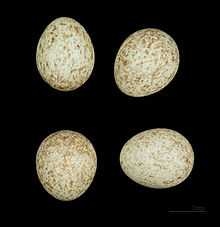Chestnut-eared bunting
| Chestnut-eared bunting | |
|---|---|
 | |
| Conservation status | |
| Scientific classification | |
| Kingdom: | Animalia |
| Phylum: | Chordata |
| Class: | Aves |
| Order: | Passeriformes |
| Family: | Emberizidae |
| Genus: | Emberiza |
| Species: | E. fucata |
| Binomial name | |
| Emberiza fucata Pallas, 1776 | |
The chestnut-eared bunting (Emberiza fucata, also called grey-headed bunting) is a passerine bird in the bunting family Emberizidae.
Description
It is 15 to 16 cm in length. The plumage is mostly brown with dark streaks. The male has a grey crown and nape with dark streaks, chestnut ear-coverts and bands of black and chestnut across the breast. There is a rufous patch on the shoulders and the rump is also rufous. Females are similar to the males but duller with a less distinct head and breast pattern. First-winter birds are plainer but show warm brown ear-coverts and have an obvious ring around the eye.
Its voice is similar to the rustic bunting but quieter. The song is a rapid twittering which begins with staccato notes and then accelerates before ending with a distinctive two or three note phrase. The call is an explosive pzick.
Distribution and habitat
The breeding range extends from the Himalayas locally across China to south-eastern Siberia, Korea and northern Japan. Northern birds migrate south to winter in southern Japan, southern China, Taiwan, north-east India and south-east Asia. The species is a vagrant to Kazakhstan and in October 2004 the first European record occurred at Fair Isle in Scotland. Preferred habitats include scrub, fields and grassland.
Reproduction
The cup-shaped nest is built at ground level or low in a bush. Three to six eggs are laid with four being most common. These are whitish with reddish-brown speckling and are incubated for 12 days. The breeding season is variable, lasting from May to August in India, May to July in Honshū and June to August in Hokkaidō.

Subspecies
There are three subspecies. The nominate subspecies E. f. fucata occupies the northern part of the range. E.f. arcuata is found in the Himalayas and south-west and central parts of China; it is darker with broader breastbands. The third subspecies E. f. kuatunensis lives in south-east China and is darker and more rufous above with narrower breastbands.
References
- ↑ BirdLife International (2012). "Emberiza fucata". IUCN Red List of Threatened Species. Version 2013.2. International Union for Conservation of Nature. Retrieved 26 November 2013.
- Mark A. Brazil (1991) The Birds of Japan, Christopher Helm, London
- Richard Grimmett, Carol Inskipp & Tim Inskipp (1999) Pocket Guide to the Birds of the Indian Subcontinent, Christopher Helm, London
- Woo-Shin Lee, Tae-Hoe Koo & Jin-Young Park (2000) A Field Guide to the Birds of Korea, LG Evergreen Foundation, Seoul
- John MacKinnon & Karen Phillipps (2000) A Field Guide to the Birds of China, Oxford University Press, Oxford
- Craig Robson (2002) A Field Guide to the Birds of South-East Asia. New Holland, London.
